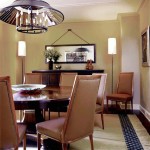How To Decorate the Walls Of Your Living Room
The living room, often considered the heart of a home, deserves meticulous attention to detail, particularly regarding wall décor. The walls provide a canvas upon which the overall aesthetic of the room is painted. Selecting appropriate wall decorations can transform a mundane space into a vibrant and inviting environment, reflecting the homeowner's personality and taste. This article provides a comprehensive guide on how to decorate the walls of a living room, exploring various options and considerations to create a visually appealing and harmonious space.
Before embarking on any decorating project, a thorough assessment of the existing space is crucial. Factors such as wall size, color, texture, and the overall architectural style of the room should be taken into account. The existing furniture and its arrangement also play a significant role in determining appropriate wall décor. A small living room, for instance, will benefit from lighter colors and strategically placed mirrors to create an illusion of spaciousness. Conversely, a larger living room can accommodate bolder colors and more substantial pieces of art. The lighting, both natural and artificial, should also be considered, as it can significantly impact how wall decorations appear at different times of the day.
Choosing the Right Wall Color
The initial step in decorating any room typically involves selecting the appropriate wall color. This choice sets the foundation for the entire décor scheme. Neutral colors, such as whites, grays, and creams, offer versatility and can be easily paired with a wide range of furniture and accessories. These colors create a sense of calm and spaciousness, making them ideal for smaller living rooms. However, neutral tones can sometimes appear bland if not complemented with pops of color through artwork, textiles, or other decorative elements.
For those seeking a more dramatic effect, bolder colors such as deep blues, greens, or even reds can be considered. However, it’s crucial to use such colors judiciously, especially in smaller rooms, as they can make the space feel cramped. An accent wall, painted in a bold color while the remaining walls are kept neutral, can be an effective way to introduce color without overwhelming the room. Consider the psychology of colors; for example, blue is often associated with tranquility, while red can evoke feelings of energy and excitement. Select colors that align with the desired mood and atmosphere of the living room.
Beyond color, the finish of the paint also plays a crucial role. Matte finishes offer a non-reflective surface that hides imperfections and provides a soft, elegant look. Satin finishes are slightly more reflective and easier to clean, making them suitable for high-traffic areas. Gloss finishes are the most reflective and durable, but they also highlight any imperfections in the wall. Eggshell finishes offer a balance between matte and satin, providing a subtle sheen and good durability.
Selecting and Arranging Wall Art
Wall art is a versatile and effective way to personalize a living room. The possibilities are endless, ranging from paintings and photographs to prints, tapestries, and sculptural pieces. The selection of art should reflect the homeowner's personal taste and complement the overall style of the room. For a modern living room, abstract art or minimalist prints may be appropriate. Conversely, a more traditional living room might benefit from landscape paintings or framed family photographs.
When choosing wall art, consider the size and scale of the pieces in relation to the wall space. A large wall can accommodate a single statement piece or a gallery wall consisting of multiple smaller pieces. Smaller walls may be better suited to a single, well-chosen piece of art. The color palette of the artwork should also be considered. Ideally, the colors should complement the wall color and the overall color scheme of the room.
The arrangement of wall art is equally important. A gallery wall, for instance, requires careful planning to create a cohesive and visually appealing display. The pieces should be arranged in a balanced and harmonious manner, taking into account their size, shape, and color. A common technique is to start with a central piece and then arrange the other pieces around it, maintaining a consistent spacing between them. Another approach is to create a grid-like arrangement, with the pieces aligned horizontally and vertically. Before committing to any arrangement, it is advisable to lay out the pieces on the floor to experiment with different layouts.
Framing can also enhance the visual impact of wall art. Choosing frames that complement the artwork and the overall style of the room is crucial. For example, a sleek, minimalist frame might be appropriate for a modern print, while a more ornate frame might be better suited for a traditional painting. The size and color of the frame should also be considered. A frame that is too large or too small can detract from the artwork. The color of the frame should complement the colors in the artwork and the wall color.
Incorporating Decorative Objects and Textures
Beyond traditional wall art, incorporating decorative objects and textures can add depth and interest to a living room's walls. This can include items such as mirrors, shelves, wall sculptures, and even decorative plates. Mirrors are particularly effective for creating an illusion of space and reflecting light, making them ideal for smaller or darker living rooms. They come in various shapes and sizes, from large statement mirrors to smaller decorative mirrors. When placing a mirror, consider what it will reflect. Ideally, it should reflect a pleasant view or a well-lit area of the room.
Shelves are both functional and decorative, providing a space to display books, plants, and other decorative objects. Floating shelves, which are mounted directly to the wall without visible brackets, offer a clean and modern look. Traditional shelves, with visible brackets, can add a more rustic or traditional touch. When styling shelves, it’s important to create a balanced and visually appealing display. Avoid overcrowding the shelves, and vary the height and size of the objects. Consider incorporating books, plants, candles, and other decorative items to create a layered and interesting display.
Wall sculptures can add a three-dimensional element to the walls, creating visual interest and texture. They can range from abstract metal sculptures to more traditional ceramic or wooden pieces. The selection of wall sculptures should complement the overall style of the room and reflect the homeowner's personal taste. When placing a wall sculpture, consider its size and scale in relation to the wall space. A large wall sculpture can serve as a focal point, while smaller sculptures can be grouped together to create a more dynamic display. Decorative plates, hung on the wall, can also add a unique and eclectic touch to a living room. This is particularly effective for showcasing antique or collectible plates.
The use of textured wall coverings, such as wallpaper or textured paint, can also significantly enhance the appearance of a living room's walls. Wallpaper comes in a wide variety of patterns and textures, from subtle floral designs to bold geometric patterns. Textured paint can create a subtle yet noticeable texture on the walls, adding depth and interest. When choosing wallpaper or textured paint, consider the overall style of the room and the desired mood. A subtle texture can add warmth and depth without overwhelming the space, while a bolder pattern can create a more dramatic effect. The lighting in the room should also be considered, as it can affect how the texture appears.
Ultimately, decorating the walls of a living room is a personal endeavor. By carefully considering the factors outlined above, and by experimenting with different options, it is possible to create a space that is both visually appealing and reflective of the homeowner's individual style. The key is to approach the process with careful planning and an eye for detail, ensuring that each element contributes to a cohesive and harmonious overall effect.
:strip_icc()/cdn.cliqueinc.com__cache__posts__268171__emily-henderson-target-design-advice-268171-1537395824654-image.700x0c-3bf5dbafc49045e5b14c9ad244891f94.jpg?strip=all)
40 Best Living Room Wall Décor Ideas

15 Wall Decor Ideas For Living Room Decorpot

How To Decorate A Large Wall In Your Living Room Express Co

10 Brilliant Living Room Wall Decor Ideas Designcafe
:strip_icc()/cdn.cliqueinc.com__cache__posts__250637__living-room-wall-decor-ideas-250637-1519691875170-image.700x0c-26e8f1a9a0f94a70a0d92bb267bf0820.jpg?strip=all)
40 Best Living Room Wall Décor Ideas

Home Decor Tips 10 Wall Decoration Ideas To Revamp Your Walls

20 Living Room Wall Decor Ideas

27 Stunning Living Room Wall Decor Ideas Displate Blog

10 Brilliant Living Room Wall Decor Ideas Designcafe

27 Stunning Living Room Wall Decor Ideas Displate Blog
Related Posts







